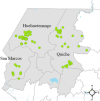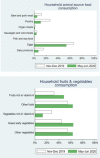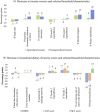Short-term impacts of COVID-19 on food security and nutrition in rural Guatemala: Phone-based farm household survey evidence
- PMID: 34149131
- PMCID: PMC8206951
- DOI: 10.1111/agec.12629
Short-term impacts of COVID-19 on food security and nutrition in rural Guatemala: Phone-based farm household survey evidence
Abstract
This article examines the short-term effects of the COVID-19 lockdown on food security and nutrition in rural Guatemala. We rely on a comprehensive panel dataset of 1,824 small agricultural households collected over two survey rounds, on November-December 2019 and May-June 2020. We place special emphasis on changes in agricultural and nonagricultural income sources, including remittances, and changes in dietary diversity, including consumption of animal source foods (ASF) and fruits and vegetables (F&V). We find that COVID-19 affected the incomes, food security, and dietary patterns of households, with a decrease in ASF diversity and an increase in F&V diversity, and an overall net decrease in dietary diversity across all food groups. Dietary diversity among women in reproductive age, however, remained unchanged, and increased among children under 2 years old. Interestingly, households with relatively higher incomes appear to have reduced their dietary diversity to a larger extent than lower income ones, as well as households located in communities with more severe access restrictions. The focus of the study in a region with a high prevalence of poverty and chronic malnutrition provides an important perspective into the consequences of the lockdown in complex rural contexts with vulnerable populations and contributes to inform eventual recovery measures.
Keywords: COVID‐19; agricultural households; dietary diversity; food security; income.
© 2021 The Authors. Agricultural Economics published by Wiley Periodicals LLC on behalf of International Association of Agricultural Economists.
Figures





References
-
- Abate, G. , De Brauw, A. , & Hirvonen, K. (2020). Food and nutrition security in Addis Ababa, Ethiopia during COVID‐19 pandemic: June 2020 report [ESSP Working Paper 145]. International Food Policy Research Institute (IFPRI).
-
- Akter, S. , & Basher, S. A. (2014). The impacts of food price and income shocks on household food security and economic well‐being: Evidence from rural Bangladesh. Global Environmental Change, 24(25), 150–162.
-
- Allen, L. H. , & Gillespie, S. (2001). What works? A review of the efficacy and effectiveness of nutrition interventions. Asian Development Bank.
-
- Arimond, M. , & Ruel, M. T. (2004). Dietary diversity is associated with child nutritional status: Evidence from 11 demographic and health surveys. The Journal of Nutrition, 134(10), 2579–2585. - PubMed
-
- Ballard, T. J. , Kepple, A. W. , & Cafiero, C. (2013). The Food Insecurity Experience Scale: Development of global standard for monitoring hunger worldwide. FAO Technical Paper Version 1.1 FAO.
LinkOut - more resources
Full Text Sources
